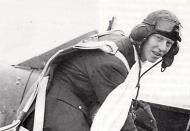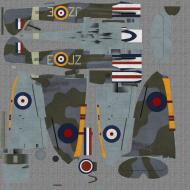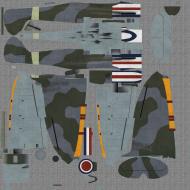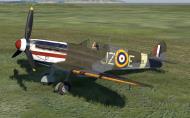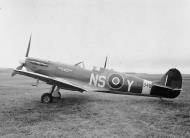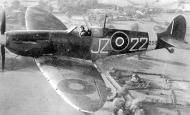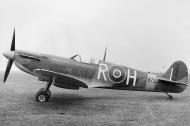RAF No 57 Operational Training Unit
RAF No 57 Operational Training Unit Spitfire photographs
- IL-2 Sturmovik Cliffs of Dover - COD/CLOD skins
- COD KS MkI RAF 57OTU JZE James Ginger Lacey AR213 England 1942
- COD KS MkI RAF 57OTU JZE James Ginger Lacey AR213 England 1942 NM
- COD KS MkI RAF 57OTU JZE James Ginger Lacey AR213 England 1942 V0A
Have fun KS Official 1C Company forum http://forum.1cpublishing.eu/
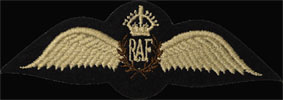
Squadron Leader James Harry ‘Ginger’ Lacey
DFM & BarSquadron Leader James Harry ‘Ginger’ Lacey DFM & Bar (1 February 1917 in Wetherby, near Leeds, Yorkshire, England – 30 May 1989) was one of the top scoring Royal Air Force fighter pilots of the Second World War and was the second highest scoring British RAF fighter pilot of the Battle of Britain, behind P/O Eric Lock of No. 41 Squadron RAF. Lacey was credited with 28 enemy aircraft destroyed, five probables and nine damaged.
Lacey left King James Grammar School, Knaresborough in 1933. After four years as an apprentice pharmacist, he joined the RAFVR (Royal Air Force Volunteer Reserve) in January 1937 as a trainee pilot at Perth, Scotland. In 1938, he then took an instructor's course, becoming an instructor at the Yorkshire Flying School. Called up at the outbreak of war, he joined No. 501 Squadron RAF.
Second World War
Battle of France
On 10 May 1940, the Squadron moved to Bétheniville in France where he experienced his first combat. On 13 May over Sedan, Lacey destroyed a Heinkel He 111 and a Bf 109 followed by a Bf 110 in the afternoon. He claimed two more He 111s on 27 May, before the squadron was withdrawn to England on 19 June, having claimed nearly 60 victories. On 9 June, he crash landed and was almost drowned in a swamp. During his operational duties in France, he was awarded the French Croix de guerre.Battle of Britain
Flying throughout the Battle of Britain with No. 501 based at Gravesend or Croydon, Lacey became one of the highest scoring pilots of the battle. His first kill of the battle was on 20 July 1940, when he shot down a Bf 109E of Jagdgeschwader 27. He then claimed a destroyed Ju 87 and a ‘probable’ Ju 87 on 12 August along with a damaged Bf 110 and damaged Do 17 on 15 August, a probable Bf 109 on 16 August. He destroyed a Ju 88, damaged a Do17 on 24 August and shot down a Bf 109 of Jagdgeschwader 3 on 29 August. He bailed out unharmed after being hit by return fire from a Heinkel He 111 on 13 August.On 23 August, Lacey was awarded the Distinguished Flying Medal.
On 30 August 1940, during combat over the Thames Estuary, Lacey shot down a He 111 and damaged a Bf 110 before his Hurricane was badly hit from enemy fire. His engine stopped and he decided to glide the stricken aircraft back to the airfield at Gravesend instead of bailing out into the Estuary.
A highly successful August was completed when he destroyed a Bf 109 on the 31st.
On 2 September, Lacey shot down two Bf 109s and damaged a Do 17. He then shot down another two Bf 109s on 5 September. During a heavy raid on 13 September, he engaged a formation of Kampfgeschwader 55 He 111s over London where he shot down one of the bombers that had just bombed Buckingham Palace. He then bailed out of his aircraft, sustaining slight injuries, as he could not find his airfield in the worsening visibility.
Returning to the action shortly thereafter, he shot down a He 111, three Bf 109s and damaged another on 15 September 1940, one of the heaviest days of fighting during the whole battle, which later became known as ‘Battle of Britain Day’.
Two days later on 17 September, he was shot down over Ashford, Kent during a dogfight with Bf 109s and bailed out without injury. On 27 September, he destroyed a Bf 109 and damaged a Ju 88 on 30 September. During October he claimed a probable Bf 109 on 7 October, shot down a Bf 109 on 12 October, another on 26 October and on 30 October, he destroyed a Bf 109 before damaging another.
During the Battle of France and the Battle of Britain, Lacey had been shot down or forced to land due to combat no less than nine times.
On 26 November 1940, with 23 claims (18 made during the Battle of Britain) Lacey received a Bar to his Distinguished Flying Medal for his continued outstanding courage and bravery during the Battle of Britain.
After 1940
In January 1941, Lacey was commissioned and promoted to Acting Flight Lieutenant in June. On 10 July 1941, as ‘A’ Flight Commander, he shot down a Bf 109 and damaged another a few days later on the 14 July. On 17 July, he claimed a Heinkel He 59 seaplane shot down and on 24 July, two Bf 109s (by causing them to collide). He was posted away from combat operations during August 1941, serving as a flight instructor with 57 OTU (Operational Training Unit).During March 1942, Lacey joined No. 602 Squadron, based at Kenley flying the Spitfire Mk V and by 24 March had claimed a Fw 190 as damaged. He damaged another Fw 190 on 25 April 1942 before a posting to 81 Group as a Tactics Officer and later that year, in November, as Chief Instructor at the No. 1 Special Attack Instructors School, Milfield.
In March 1943, Lacey was posted to No. 20 Squadron, Kaylan in India before joining 1572 Gunnery Flight in July of the same year to convert from Blenheims to Hurricanes and then to Republic P-47 Thunderbolts. He stayed in India, being posted to command 155 Squadron flying the Spitfire VIII in November 1944 and then as CO No. 17 Squadron later that month. While based in India, Lacey claimed his last aircraft on 19 February 1945, shooting down a Japanese Army Air Force Nakajima Ki 43 ‘Oscar’ with only nine 20mm cannon rounds.‘Ginger’ Lacey was one of the few RAF pilots on operational duties on both the opening and closing day of the war. His final tally was 28 confirmed, four probables and nine damaged.
Postwar
After the war was over, Lacey went to Japan with No. 17 Squadron, becoming the first Spitfire pilot to fly over Japan on 30 April 1946. He returned to the UK in May 1946. After receiving a permanent commission in December 1948, Lacey retired from the RAF on 5 March 1967 as a Flight Lieutenant; he retained the rank of Squadron Leader.
After retirement, Lacey ran an air freight business and instructed at a flight school near Bridlington, UK.
Death‘Ginger’ Lacey died on 30 May 1989 at the age of 72. In September 2001, a plaque was unveiled at Priory Church, Bridlington, Yorkshire in memory of the fighter pilot and ace.
http://en.wikipedia.org/wiki/James_Harry_Lacey
Above: Official portrait of Demosthenes Demades, probably after his graduation from flight training and his promotion to Sergeant. When Italy attacked Greece, on October 26, he decided to quit his studies and join the fight, although he could avoid it, for being the only son of a Greek wealthy family. He paid the ultimate price when he was killed during his operational training with the No.57 OTU. He was buried in Brookwood Military Cemetery in England (Eugene Panagopoulos via New York Magazine). Middle: No.57 OTU students and instructors during 1943. Judging from their heavy clothing the time the photo was taken should be either Autumn, either Winter. Usually, pilots completed their operational training in approx. 45 day. Considering the fact that Demades killed on October 11, and the sortie he flew that day required an experienced student, he might be posted to No.57 OTU during the last days of August or the beginning of September. If the photo was taken in Autumn then the man left of the spinner on the second row might be him as his characteristics match those of the Greek pilot. (Martin Pengelly)
Below: Spitfire Mk.I AR212 was one of the most famous Spitfires, because of their distinctive nose markings. Its was a 'Jumper' aircraft or as we could call it in our days, an adversary fighter. It was flown by the well-respected ace, James Storrar while he was serving as an instructor with the No.57 OTU. In fact, he had this picture pinned in his logbook in which it is also written: ”My yellow-nosed Spitfire, the only one of its kind, used to frighten pupils. It looked exceptionally smart and the girlfriends never failed to recognize it". (Phil Listemann, further notes via Ed Russel from www.britmodeller.com)
Although our team addressed questions to notable researchers and institutions like Andy Thomas, Phil Listeman and Ioannis Mylonas as well as the Air Britain, we weren’t able to find a photo of the presentation Spitfire Mk.I, R7063 D.S.G. WORTH VALLEY, in which the Greek pilot was killed. For that reason, the above Spitfire profile is hypothetical, for many reasons. The name was written according to the rules applied for such occasions, regarding the fonts, their size, and their colors. The identification letters for the No.57 OTU is a quite interesting story considering the fact that the unit had four separate codes from 1941 to 1945 which were used almost at the same time, specifically 'LV', 'PW', 'JZ' and 'XO'. Reading Andy Thomas and Vic Flintham book COMBAT CODES we discovered that the Spitfires Mk.Is were used by No.57 OTU from 1941 to 1943 and by photographic evidence those used the codes 'LV' and 'PW'. Going back to the profile we had to choose, so we decided to use ‘PW’. We also didn’t know the specific identification letter for the R7063 so we use D as a tribute to his name. The fighter carries the typical day camouflage used in 1943 and no rear view mirror. (Copyright by Bertrand Brown)
Above: Spitfire Mk.IIa P7296/JZ-22 of No.57 OTU, Hawarden c1942/43). Before entered its service with the OTU, the P7296 saw extended service with the No.266 Squadron (force-landed safely in Little Bytham by Sgt Goodwin), No.234 Squadron, No.64 Squadron and finally No.504 Squadron. (RAF Museum P005112 via Andrew Thomas and Phil Listemann)
Middle: One more example regarding a No.57 OTU Spitfire Mk.Ia is the X4486/PW-L which was the raw model for the profile we created above. Before RAF Eshott it also served with No.72 and No.122 Squadrons as well as with the No.61 OTU. While serving with the No.57 OTU its engine failed on May 11, 1943, and it was written off after a total of 827,50 hours of flying time. (Andrew Thomas)
"We were friends and we were studied together in Newcastle, England. During 1940 we heard early in the morning on the radio:
"Greece enters the war, because of OXI to the enemy provocation".
A few days later both of us requested from the Greek Embassy to return back to Greece and join the armed forces. The answer they got was:
"Mediterranean is closed. We can’t send you back, however, you can request to be enlisted to allied forces"
"Let’s join the Air Force", Demades said.
"No let’s go to the Navy", I responded
"To the bombers, to the fighters, to the submarines, whatever", he replied.
Our paths got separated….It’s 1943. Our fleet leaves Tobruk, ready for a fight. Far away from us, moving carefully between the minefields at dawn, another Greek destroyer closing us and start signaling us with the searchlight.
"For Officer Panagopoulos"
"From Officer Saliaris"
"Demos was killed." Nothing else. Our friend and the only child in his family was gone.
It’s 1945. We are back home. During Demos memorial day I see his mother. What could I tell her?
"We are ashamed that we survived". I couldn’t find any other words.
How many times I saw the huge flames from a plane which crash over land or water. The fire of Hector and Patroklos. What a grandiose way to leave from this world. Now he would be 64. Would I be able to recognize him if he was alive? How he might look compared to his young joyful look? Suddenly a hand touches me in my shoulder. It’s my brother in law, Willie who drove me to his grave with his car.
"Let’s go, what happens to you. Did you fall asleep?" I was surprised.
"Let’s go", I told him.
I cut a twig of a blossomed thyme in front of his grave and took it with me to give it to his mother. Goodbye, my old friend. I became 64. So what?"
London 1983
Demosthenes Demades is one more of the unknown heroes we will never hear in Greece. We will never hear about the young student who quit his studies in order to join the fight for freedom. However most of us, at least those of us who live in Athens passed at least once outside his house. According to α Real Estate site:
"The of stone prewar house at the Poseidon Avenue (no53), in Paleo Faliro, built in 1939 by the shipowner Anthony Demades and in the late 70s, the remaining member of his family, Miss Demades, at that time bedridden and having moved to Kipseli area, sold the title deeds to the shipowner Stavros Ntaifas. One term of the contract was to never uproot from the courtyard the olive tree and the fig tree, once planted by her son, who was killed serving as a pilot in RAF. The new owner complied with this and also planted a very high palm tree in the yard. Ntaifas, a well-known shipowner and vice president of the Union of Greek Shipowners for many years, has also played a key role in Greek football - it was said that in a backgammon game, he and his best man George Vardinogiannis decided to buy each a football team, Ntaifas Olympiakos team, and Vardinogiannis Panathinaikos team. After Ntaifas's death, the house was inherited by his only daughter, Irene, also the heiress of the shipping empire and recently the municipal cultural counselor in Piraeus! The villa is overseen by a security guard's cab with external video cameras and it is said that its interior, although recently restored, is still adorned by famous Greek paintings, art deco furniture, antique chandeliers and sconces and a pianola from the known British firm John Broadwood & Sons."
May and his sacrifice and his memory be eternal.Sergeant Demosthenes Demades was a Greek pilot of the Royal Air Force Volunteer Reserve who died during the Second World War. He was born in 1919, the son of Captain Anthony and Zinovia Demades, of Piraeus, Greece. He was studying in Newcastle when Greece entered the war and he tried to return to his homeland in order to join the armed forces. Unable to travel to Greece he opted for service with the Allies wanting to be a pilot. After enlisting to RAF, Demades was sent to Canada in order to attend the BCATP. His initial flight training took place in No.33 EFTS at Caron Canada flying DH82As Tiger Moths. He continued to No.41 SFTS at Weyburn, Canada flying the famous Harvard, before he returned back to England. Once back on the British Isles he was posted to No.5 (F) AFU and Miles Masters and then he proceeded for his operational training on Spitfires in No. 57 OTU at RAF Eshott. On October 11, 1943, he took off, flying his Supermarine Spitfire Mk.I R7063 for a training sortie, practicing attacks, climbs and dogfights with his instructor P/O Charron. During their engagement, Demades fighter spun in and crashed at Eshott Hall, near Morpeth at 16:14. According to his instructor P/O Phillip Charron:
At 14:30 hrs I attended a briefing given by the Flight Commander to the white section of which I was to be the leader. We were briefed to carry out section attacks on a target aircraft then a battle climb and them practice dogfights, between Nos. 1 - 2 and 3 - 4, of white section....We took off at 15:45 hrs. and the formation joined up at 15:10 hrs. We climbed to 8,000 ft. and intercepted the target aircraft on which we made attacks for approximately 50 minutes. We then climbed to 21,000 ft. While climbing I called each member of the white section and told him to check oxygen supply. I received a satisfactory reply from each member. After reaching 21,000 ft. I called up Nos. 3 and 4 of the section and told them to break away and commence practice dogfighting. Flying further, away I told No. 2 to go to long line astern for a practice dogfight. I then asked him if he was in position and received an affirmative reply, thereupon I call back "Here we go" and the practice commenced. I carried out some moderately violent evasive maneuvers followed by a steep dive down to approximately 15,000 feet. I then pulled up sharply into the sun. after my speed dropped off I swichtailed right and left to see where my No.2 was. I couldn't see him. I was now at approximately 19,000 feet and searched the area for him but could find no trace. I then aerobated gently down to 10.000 feet and then came down into the circuit, and landed. It was only after reaching dispersal that I learned that Sgt. Demades had crashed."
The whole incident unveiled in front of No.57 OTU Flying Control Officer, P/O Geoffrey Derek Addinsall who stated:
"...at approximately 16:15 I was bicycling along the western perimeter track of the airfield when I noticed an aircraft which was a Spitfire at 5,000 to 6,000 ft. performing what appeared to me to be aerobatics. I noticed that at the top of a loop he "flicked off the top" and went into a particularly vicious spin. At approximately 2,500 ft. he appeared to level out and the spin reduced but at approximately 2,000 ft he appeared to pull the nose up and immediately go into a very flat spin, from which he did not recover and crashed about 2 miles southeast of my position."
Details of how the unfortunate Greek pilot crashed were also given by Flt. Lt. Kenneth Charles Michael, Flight Commander of 'E' Flight in his report:
"...I was in my dispersal office. I heard a loud whine which sounded like an aircraft, in an excessive dive. I went outside and saw an aircraft spinning at about 3,000 ft. After it had lost another 1,000 ft. the aircraft appeared to go into a flat spin from which it did not recover and crashed about two miles to the southeast from the airfield. Soon afterward I learned it was Sgt. Demades who had crashed. Sgt. Demades was a pilot of average ability. He had completed over 50 hrs of Spitfire flying, and was in his third phase of training at this Unit."
No evidence of structural fault or oxygen system fault or any other cause which could blame the R7063 was found. The conclusion of the investigation was signed by the CO of RAF Eshott, Allan Hope:
"I concur with the remarks of the Investigating Officer. It seems that he has established that no blame attaches to anyone except the pilot, the crash being caused by the fact that he had got into difficulties. It seems that the reason for his inability to get out of these difficulties is best ascribed to the fact that he had not done more than 206 hours flying in all."
Sergeant Demades 1512536 (Greek) aged 24 of Piraeus, was buried in Section 25, Row E, Grave 1, Brookwood Military Cemetery, Woking, Surrey. During his studies in England, he was a fellow student to another Greek shipowner Eugenios Panagopoulos with-whom Demosthenes was a close friend. He served with the Royal Greek Navy as well as the USN after Greece liberation. In an article on a Greek American Magazine dated back in 1983, Eugenios wrote his thoughts after visiting his friends grave:
Magazine References: +
- Airfix Magazines (English) - http://www.airfix.com/
- Avions (French) - http://www.aerostories.org/~aerobiblio/rubrique10.html
- EDUARD - https://www.eduard.com/
- EDUARD - Are in my opinion are what modelers are looking for loads of pictures and diagrams and have become a leading historical information source. *****
- FlyPast (English) - http://www.flypast.com/
- Flugzeug Publikations GmbH (German) - http://vdmedien.com/flugzeug-publikations-gmbh-hersteller_verlag-vdm-heinz-nickel-33.html
- Flugzeug Classic (German) - http://www.flugzeugclassic.de/
- Klassiker (German) - http://shop.flugrevue.de/abo/klassiker-der-luftfahrt
- Luftwaffe IM Focus (German) - https://www.luftfahrtverlag-start.de/
- Embleme der Luftwaffe Band-1 (German) - https://www.luftfahrtverlag-start.de/
- Le Fana de L'Aviation (French) - http://boutique.editions-lariviere.fr/site/abonnement-le-fana-de-l-aviation-626-4-6.html
- Le Fana de L'Aviation (French) - http://www.pdfmagazines.org/tags/Le+Fana+De+L+Aviation/
- Osprey (English) - http://www.ospreypublishing.com/
- model airplane international magazine - https://adhpublishing.com/shop/store/magazine-backissues/model-airplane-international-backissues/
- Revi Magazines (Czech) - http://www.revi.cz/
Web References: +
- eBay - https://picclick.de/ or https://www.ebay.com
- Pinterest - https://www.pinterest.com
- History of RAF Organisation: http://www.rafweb.org
- History of RAAF: http://www.airpages.ru/eng/ot/raaf_01.shtml
- Wikipedia, the free encyclopedia: http://en.wikipedia.org/
 Editor for Asisbiz: Matthew Laird Acred
Editor for Asisbiz: Matthew Laird Acred
If you love our website please subscribe to our YouTube video channel
Please donate so we can make this site even better !!

